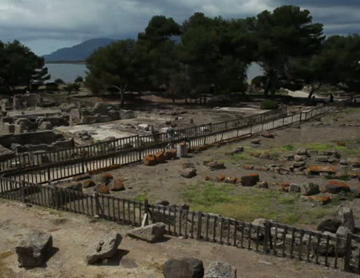The church, practically on the seashore, was built in the suburban cemetery area of the Phoenician-Punic city of Nora, where the tofet and a necropolis were located. It corresponds to the site where, according to tradition, Saint Efisio, a Roman warrior who converted to Christianity, was martyred. A first sanctuary was built here in the early Middle Ages, completely rebuilt during the Judicial Age. It is the landing place of the devotional procession that at the beginning of May honors the martyr Efisio, leading him here from the homonymous Cagliari church of Stampace, where he lives for the rest of the year.
The church of Sant'Efisio owes its environmental charm to the contrast between the warm sandstone built and the colors of the sea that laps the beach, and the architectural one to the archaic suggestion emanating from the interior, where you can still breathe an atmosphere full of devotion.
From the floor level of the presbytery emerges a domed structure, accessible today from the crypt, in which it was proposed to recognize the remains of the early medieval martyrium in which the saint was buried, before his relics were transferred to Pisa.
The sanctuary was rebuilt from scratch in proto-Romanesque forms, after the Cagliari judge Constantino Salusio II de Lacon Gunale in 1089 donated Sant'Efisio to the Benedictine abbey of San Vittore in Marseille. The construction site was probably commissioned by a Catalan-trained architect. The church was built in sandstone and limestone blocks of maximum size, recovered from the walls of ancient Nora. On the S side, a Phoenician-Punic funerary stele was reused.
The floor plan has three naves, all with barrel vaults reinforced by grooves. The naves are divided by arches that are set up on sturdy pillars. The apse, arranged in S/E, has no single light, so the light penetrated only those open along the sides.
The Romanesque façade was located where the surviving sailing bell tower stands today, but between the 17th and 18th centuries it was broken down and a porched atrium was placed against it.
History of studies
The church is mentioned by Vittorio Angius (1847) and in the “Itinerary” by General Alberto della Marmora (1860). Its importance for the history of medieval architecture in Sardinia stands out in the work of Raffaello Delogu (1953). After the article by Foiso Fois (1964), who published the paper, the most recent contributions are due to Renata Serra (1989) and Roberto Coroneo (1993).
Bibliography
V. Angius, entry “Pula”, in G. Casalis, Historical and Statistical-Commercial Geographical Dictionary of the States of His Excellency the King of Sardinia, XV, Turin, G. Maspero, 1847, pp. 779-780;
A. Della Marmora, Itinerary of the Island of Sardinia, Cagliari, Alagna, 1868, pp. 101-102;
R. Delogu, The Architecture of the Middle Ages in Sardinia, Rome, The State Library, 1953, pp. 54-55; F. Fois, “A note on three Victorian churches of Cagliari”, in Sardinian Historical Archive, XXIX, 1964, pp. 277-284;
M. Botteri, Guide to the medieval churches of Sardinia, Sassari, Chiarella, 1978, p. 113;
R. Serra, Sardinia, series “Romanesque Italy”, Milan, Jaca Book, 1989, p. 336; R. Coroneo, Romanesque architecture from the middle of the thousand to the early '300, Nuoro, Ilisso, 1993, sheet 5;
R. Coroneo-R. Serra, Pre-Romanesque and Romanesque Sardinia, series “Italian artistic heritage”, Milan, Jaca Book, 2004, pp. 248-249; R. Coroneo, Romanesque Churches of Sardinia. Cultural tourist itineraries, Cagliari, AV, 2005, p. 100.
Content type:
Religious architecture
Province: Cagliari
Common: Pula
Macro Territorial Area: South Sardinia
POSTAL CODE: 09050
Address: viale Nora, s.n.c.
Update
Where is it
Images


Results 2 of 103658
View AllVideo

Author : Spadetta Giulio

Results 2 of 42497
View All
Comments